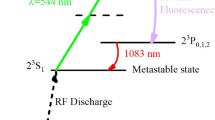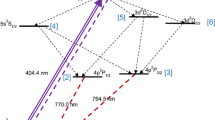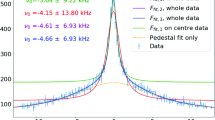Abstract
We have demonstrated Doppler-free intermodulated fluorescence spectroscopy of helium 23P–31,3D transitions in an rf-discharged sealed-off cell using a compact laser system at 588 nm. An external cavity diode laser at 1176 nm was constructed to seed a Raman fiber amplifier. Laser power of more than 1 W at 588 nm was produced by frequency doubling of the fiber amplifier output using a MgO:PPLN crystal. A doubling efficiency of 23 % was achieved. The power-dependent spectra of the 23P–33D transitions were investigated. Furthermore, the Doppler-free spectrum of the spin-forbidden 23P–31D transitions was observed for the first time. Our results are crucial toward precision test of QED atomic calculations, especially for improving the determination of the helium 31D–33D separation.
Similar content being viewed by others
Avoid common mistakes on your manuscript.
1 Introduction
As the simplest multi-electron atom, helium is of both experimental and theoretical interests due to its calculable electronic structures. Precision spectroscopic measurements on the helium transitions, such as absolute transition frequencies [1–6], fine-structure intervals [7–11], and isotope shifts [1, 4, 12, 13], have played essential roles for testing quantum electrodynamics (QED) in many-body atomic calculations [14, 15]. The accuracy of the spectroscopic measurement depends on the linewidth and the signal-to-noise ratio (SNR) of the measured spectrum. Therefore, Doppler-free techniques have been widely used in precision spectroscopy [4–8]. Particularly, zero-background Doppler-free scheme, such as polarization spectroscopy [16, 17], intermodulated optogalvanic spectroscopy [18, 19], intermodulated fluorescence spectroscopy [20], resonance ionization spectroscopy [21], and crossed laser–atomic beam methods [5–8, 11, 12], are powerful techniques to improve spectral SNR for observing weak transitions.
The Doppler-free spectroscopy of the helium 23P–31,3D transitions is essential to determine the ionization energy of the 23P state and investigate the fine-structure and hyperfine intervals of the 23P and 33D states [18, 20]. Furthermore, it is also of interest to study the singlet–triplet mixing of the 31D and 33D states [20, 22]. Moreover, the separation between 33D and 31D states can be precisely determined by measuring the absolute frequencies of the Doppler-free spectra of 23P–31,3D transitions to resolve a discrepancy of 7.4 σ (37 MHz) between the theories and experiments of the 31D–33D separation in 3He [23]. The first observation of the Doppler-free spectrum of the 23P–33D transitions has been demonstrated by means of intermodulated optogalvanic spectroscopy in a DC discharge cell. The hyperfine intervals of the 3He 33D state were reported [18]. In a later report [20], Doppler-free spectra of the 4He 23P–33D transitions were performed in a DC discharge cell using intermodulated fluorescence spectroscopy. However, the Doppler-free spectrum of the spin-forbidden 23P–31D transitions could not be obtained. Only the Doppler-limited fluorescence spectrum of the 23P–31D transitions was observed by focusing 120 mW laser beam into the DC discharge cell. Up to now, no Doppler-free spectrum of the 23P–31D spin-forbidden transitions has been reported.
In these previous experiments, the spectroscopy of the helium 23P–31,3D transitions at 588 nm was performed using a dye laser system [18, 20, 22]. The laser power of a few hundred mW can be typically obtained. Nevertheless, the dye laser system is bulky and difficult to maintain. Thanks to the recent development of the quantum-dot semiconductor laser [24] and the nonlinear optical technique [25], a high-power yellow laser based on frequency doubling of a diode laser system with a Raman fiber amplifier has been demonstrated [26], which is much more compact and stable than the dye laser.
In this letter, we report the observation on the Doppler-free intermodulated fluorescence spectroscopy of the 23P–31,3D transitions in 4He. The spectra were performed in an rf-discharged cell using a compact laser system. Laser power of more than one watt at 588 nm was produced based on the efficient single-pass second-harmonic generation (SHG) of a fiber-coupled external cavity diode laser with a Raman fiber amplifier at 1176 nm. The Doppler-free signals of 23P–33D transitions in different laser power were studied. Most importantly, to the best of our knowledge, it was the first time that the Doppler-free spectroscopy of the spin-forbidden 23P–31D transitions was observed.
2 Experimental methods
A schematic drawing of the related helium energy levels is shown in Fig. 1a. The helium atoms at the 23P states are produced by the radio-frequency (rf) discharge in a pure helium cell. For the measurement of the 23P–33D transitions, the population in the 23P states is excited to the 33D and the laser-induced fluorescence of the 33D–23P transitions at 587.7 nm is detected. In the experiment of observation on the 23P–31D transition spectrum, the population in the 23P states is excited to 31D states and fluorescence of the 31D2–21P1 transition at 668.0 nm is detected.
a Energy level diagram for Doppler-free spectroscopy of the 4He 23P–31,3D transitions. b Schematic diagram of the experimental setup. ECDL external cavity diode laser, PMFI polarization-maintaining fiber isolator, OI optical isolator, HWP half-wave plate, L lens, PPLN periodically poled LiNbO3 crystal, DM dichroic mirror, FPI Fabry–Perot interferometer, WM wavemeter, BS beam splitter, F filter, PD photodiode
The experimental setup is shown in Fig. 1b. The external cavity diode laser (ECDL) at 1176 nm was constructed in a polarization-maintaining (PM) fiber-coupled gain module (Innolume, GM-1140-120-PM-130) with the Littrow configuration. The laser wavelength was selected using a 1200 grooves/mm blazed grating. The grating was mounted on a piezoelectric transducer (PZT) to fine-tune the angle of the grating. The wavelength of the ECDL can be tuned from 1100 to 1200 nm. Besides, the mode-hop-free tuning range over 10 GHz and the power output of a few tens mW were achieved. The output of the ECDL through two PM fiber isolators (PMFI) were sent to a stimulated Brillouin scattering (SBS) suppressed PM Raman fiber amplifier [13]. About 5 W of linearly polarized narrow linewidth laser power at 1176 nm was produced. An optical isolator (OI) at the output of the Raman fiber amplifier was used to avoid the optical feedback. The power amplified laser beam was focused into an MgO-doped periodically poled LiNbO3 crystal (PPLN) for frequency doubling to 588 nm. The MgO:PPLN (HC Photonics) with a length of 50 mm and a period of 9.27 μm was temperature-controlled at 95 °C for 587.6 nm and 97 °C for 587.7 nm to achieve the quasi-phase matching (QPM). The fundamental beam waist radius at the center of the MgO:PPLN was 50 μm, which corresponds to a focusing parameter of 1.73. A dichroic mirror (DM) was placed in the output of the MgO:PPLN to separate the fundamental (1176 nm) and second-harmonic (588 nm) beams. The transmitted 1176 nm beam was sent to a Fabry–Perot interferometer (FPI) and a wavemeter (WM) for monitoring the laser operation condition. The reflective 588-nm beam was used to perform the spectroscopy of the 23P–31,3D transitions in atomic helium. Figure 2 shows the dependence of the power and efficiency of the SHG on the fundamental power. The 588-nm laser power of 1.1 W was generated at a fundamental power of 4.8 W. The frequency-doubling conversion efficiency of 23 % was obtained.
The measurement of the Doppler-free spectroscopy was performed by intermodulated fluorescence technique [27]. This technique utilizes the nonlinear effect between the two counter-propagating laser beams, which are resonant only with zero-velocity atoms. As a result, Doppler-free spectrum can be obtained. The 588-nm laser was separated into two beams by a 50:50 beam splitter (BS). Both beams were vertically polarized. One beam was chopped at 559 Hz and sent to a 15-cm rf-discharged cell from one direction, while another beam was chopped at 399 Hz and passed through the cell in the opposite direction. The sealed-off cell with Brewster windows was filled with pure 4He gas at 200 mTorr and was enclosed in three-layer mu-metal box for shielding the earth magnetic field to <1 mG. The laser-induced fluorescence from the cell passing through a narrow bandpass filter was detected by a 9.8-mm-diameter photodetector (PD). The signal from PD was demodulated at the sum frequency of 958 Hz using a lock-in amplifier.
3 Results and discussion
Figure 3 shows power-dependent Doppler-free spectra of the 4He 23P–33D transitions. The two beams were overlapped in the cell with beam diameters of approximately 3.5 mm. The laser-induced fluorescence of the 33D–23P transitions at 587.7 nm was detected. The Doppler-free spectra at six different total laser powers were presented. The power-broadening spectra were clearly observed. Figure 4 shows the dependence of the full width at half maximum (FWHM) of the 4He 23P1–33D2 ((a) in Fig. 3) on the light intensity. The FWHM at zero light intensity was determined to be 33(5) MHz, which is comparable to the natural linewidth of 12 MHz with a pressure broadening of approximately 10 MHz at 200 mTorr [28]. The saturation intensity of the 23P1–33D2 transition was determined to be 1.3(4) × 103 W/m2, which is in reasonable agreement with the calculated saturation intensity of 2.0 × 103 W/m2, given by [29],
where δν is the measured half width at half maximum (HWHM) at zero light intensity, τ −1 = τ −11 + τ −12 , where τ 1 and τ 2 are the lifetime of the upper level and lower level, respectively, A is the Einstein A coefficient of the transition, and λ is the center wavelength of the transition. Furthermore, the signal of the 23P2–33D1 transition ((h) in Fig. 3) was observed when the laser power was higher than 180 mW. In previous experiments [30], the 23P2–33D1 transition was too weak to be observed since the line strength of 23P2–33D1 transition is 45 times weaker than the 23P1–33D2 transition and the saturation intensity of the 23P2–33D1 transition is 27 times the value of the 23P1–33D2 transition. The whole-power-dependent spectra of the 23P–33D transition lines in 4He were demonstrated. Our results are significant and will be the first mile stone toward measuring absolute transition frequencies and fine-structure intervals to test QED atomic calculations.
Power-dependent Doppler-free spectra of the 23P–33D transitions in 4He. The transitions are a 23P1–33D2, d 23P1–33D1, f 23P2–33D3 and 23P2–33D2, and h 23P2–33D1. The crossover lines with the common lower levels are b and g. The crossover lines with the common upper levels are c and e. Here, the cell pressure is 200 mTorr. The rf discharge power is 22 W. The laser power is the total power of both beams, and the beam diameter (1/e) is approximately 3.5 mm
Most importantly, the Doppler-free spectra of the 4He spin-forbidden 23P1,2–31D2 transitions as well as the crossover line were obtained, as shown in Fig. 5. Before our measurement, only Doppler-limited spectra of the spin-forbidden 23P1,2–31D2 transitions of 4He were observed [20]. The main difficulty is that the line strength of the 23P1–31D2 and 23P2–31D2 transitions are 0.4 × 104 and 1.2 × 104 times weaker than the 23P1–33D2 transition. In addition, the estimated saturation intensity of the 23P1,2–31D2 transitions is three-to-four orders of magnitude higher than that of the 23P1–33D2 transition. To obtain the saturated-absorption signal, we focused the laser beam to a diameter of approximately 0.4 mm in the center of the cell to achieve enough light intensity. The laser-induced fluorescence of the 31D–21P transitions at 668.0 nm was detected as the signal. Compared with the spectra of the 23P–33D transitions, the spectra of the 23P1,2–31D2 transitions show asymmetric lineshapes. The mechanism for producing this peculiar lineshape is still under investigation. However, we have found that by changing the relative polarization of the two laser beams, the asymmetry can be reduced. In the future, we will use an optical frequency comb-stabilized laser system [31] to study the origin of this asymmetric lineshape. Optical frequency measurements of both 23P–33D and 23P–31D transitions will be performed to determine the 31D–33D separation as well as the singlet–triplet mixing coefficient. A measurement on 3He will also help to resolve the discrepancy between theory and former measurements. The anticipated error budget of these measurements is listed in Table 1. As we fit the line profile for a single scan, the uncertainty in determining the line center is approximately 100 kHz and 1 MHz for 23P–33D and 23P–31D transitions, respectively. The statistical uncertainty can then be reduced for 20 or more scans. The uncertainty of pressure shift in 23P–31D transition is expected to be much larger because the spin-forbidden signal can only be observed with larger helium pressure (>200 mTorr), and therefore, systematic study of the pressure shift can only be performed for the 23P–33D transition. The effect due to the asymmetric lineshape is difficult to estimate. In our analysis, we decompose the spectrum into a Lorenzian part and a dispersive part and find the line center of the Lorenzian part does not vary at different experimental conditions. Here we conservatively quote 2 MHz for this effect and can be further reduced once the mechanism is studied and understood.
In conclusion, we have constructed a compact laser system at 588 nm based on highly efficient SHG of a 1176-nm ECDL-seeded Raman fiber amplifier. The laser has an optical power of over 1 W at 588 nm, and it can be easily controlled and maintained. With this compact laser system, the Doppler-free spectra of the whole 23P–31,3D transition lines in 4He were observed using intermodulated fluorescence detection scheme. The Doppler-free signals of the weak 23P2–33D1 transition and the spin-forbidden 23P1,2–31D2 intercombination transitions were successfully observed for the first time. Further measurements on absolute transition frequencies, fine-structure intervals, and isotope shifts of helium 23P–31,3D transitions are essential to test QED atomic calculations. Most importantly, accurate determination of the 31D–33D separation in 3He is critical to resolve the 7.4 σ discrepancy between the theories and experiments [23]. In addition, as suggested in [32], this intercombination transition at 588 nm can be used for preparing ultracold helium atoms in the 21S state, and this is the first step toward probing 11S–21S two-photon transition by direct frequency comb spectroscopy in a magneto-optical trap. Our result clearly has demonstrated successful transfer of the atomic populations from the triplet states to the singlet states.
References
R. van Rooij, J.S. Borbely, J. Simonet, M.D. Hoogerland, K.S.E. Eikema, R.A. Rozendaal, W. Vassen, Science 333, 196 (2011)
R.P.M.J.W. Notermans, W. Vassen, Phys. Rev. Lett. 112, 253002 (2014)
P.-L. Luo, J.-L. Peng, J.-T. Shy, L.-B. Wang, Phys. Rev. Lett. 111, 013002 (2013); 111, 79901(E) (2013)
C. Dorrer, F. Nez, B. de Beauvoir, L. Julien, F. Biraben, Phys. Rev. Lett. 78, 3658 (1997)
P. Cancio Pastor, L. Consolino, G. Giusfredi, P. De Natale, M. Inguscio, V.A. Yerokhin, Pachucki. Phys. Rev. Lett. 108, 143001 (2012)
C.J. Sansonetti, J.D. Gillaspy, Phys. Rev. A 45, R1 (1992)
P. Mueller, L.-B. Wang, G.W.F. Drake, K. Bailey, Z.-T. Lu, T.P. O’Connor, Phys. Rev. Lett. 94, 133001 (2005)
P. Cancio Pastor, G. Giusfredi, P. De Natale, G. Hagel, C. de Mauro, M. Inguscio, Phys. Rev. Lett. 92, 023001 (2004); 97, 139903 (E) (2006)
T. Zelevinsky, D. Farkas, G. Gabrielse, Phys. Rev. Lett. 95, 203001 (2005); 95, 219903 (E) (2005)
J.S. Borbely, M.C. George, L.D. Lombardi, M. Weel, D.W. Fitzakerley, E.A. Hessels, Phys. Rev. A 79, 060503(R) (2009)
M. Smiciklas, D. Shiner, Phys. Rev. Lett. 105, 123001 (2010)
D. Shiner, R. Dixson, V. Vedantham, Phys. Rev. Lett. 74, 3553 (1995)
D.C. Morton, Q. Wu, G.W.F. Drake, Phys. Rev. A 73, 034502 (2006)
G.W.F. Drake, W. Nörtershäuser, Z.-C. Yan, Can. J. Phys. 83, 311 (2005)
K. Pachucki, V.A. Yerokhin, Phys. Rev. Lett. 104, 070403 (2010)
N. Ohtsubo, T. Aoki, Y. Torii, Opt. Lett. 37, 2865 (2012)
T. Wu, X. Peng, W. Gong, Y. Zhan, Z. Lin, B. Luo, H. Guo, Opt. Lett. 38, 986 (2013)
J.E. Lawler, A.I. Ferguson, J.E.M. Goldsmith, D.J. Jackson, A.L. Schawlow, Phys. Rev. Lett. 42, 1046 (1979)
G. Chevalier, J.M. Gagn, P. Pianarosa, J. Opt. Soc. Am. B 5, 1492 (1988)
C.J. Sansonetti, W.C. Martin, Phys. Rev. A 29, 159 (1984)
B.A. Bushaw, W. Nörtershäuser, G.W.F. Drake, H.-J. Kluge, Phys. Rev. A 75, 052503 (2007)
T. Fujimoto, A. Hirabayashi, S. Okuda, K. Shimizu, H. Takuma, J. Phys. B: At. Mol. Phys. 19, 571 (1986)
D.C. Morton, Q. Wu, G.W.F. Drake, Can. J. Phys. 84, 83 (2006)
A.Yu. Nevsky, U. Bressel, I. Ernsting, Ch. Eisele, M. Okhapkin, S. Schiller, A. Gubenko, D. Livshits, S. Mikhrin, I. Krestnikov, A. Kovsh, Appl. Phys. B 92, 501 (2008)
X.P. Hu, P. Xu, S.N. Zhu, Photon. Res. 1, 171 (2013)
L. Zhang, J. Hu, J. Wang, Y. Feng, Opt. Lett. 37, 4796 (2012)
M.S. Sorem, A.L. Shawlow, Opt. Commun. 5, 148 (1972)
P.J. Leo, G. Peach, I.B. Whittingham, J. Phys. B: At. Mol. Opt. Phys. 28, 591 (1995)
K. Shimoda, High Resolution Spectroscopy, Vol. 13 of Topics in Applied Physics (Springer, Berlin, 1976)
Ph. Cahuzac, R. Damaschini, Opt. Commun. 20, 111 (1977)
P.-L. Luo, Y.-C. Guan, J.-L. Peng, J.-T. Shy, L.-B. Wang, Phys. Rev. A 88, 054501 (2013)
E.E. Eyler, D.E. Chieda, M.C. Stowe, M.J. Thorpe, T.R. Schibli, J. Ye, Eur. Phys. J. D 48, 43 (2008)
Acknowledgments
This project is supported by the Ministry of Science and Technology and the Ministry of Education of Taiwan. L.-B.W. receives support from Kenda Foundation as a Golden-Jade fellow.
Author information
Authors and Affiliations
Corresponding authors
Rights and permissions
About this article
Cite this article
Luo, PL., Hu, J., Feng, Y. et al. Doppler-free intermodulated fluorescence spectroscopy of 4He 23P–31,3D transitions at 588 nm with a 1-W compact laser system. Appl. Phys. B 120, 279–284 (2015). https://doi.org/10.1007/s00340-015-6135-8
Received:
Accepted:
Published:
Issue Date:
DOI: https://doi.org/10.1007/s00340-015-6135-8









